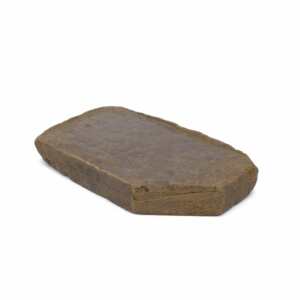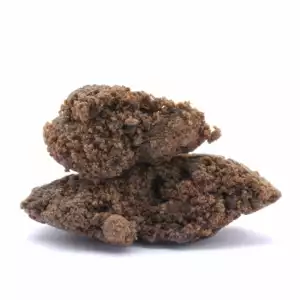Types of hash – the secret world of cannabis concentrate that’s waiting to be explored! From the classic traditional hashes to the cutting-edge rosin, this guide is your ticket to demystifying the captivating universe of hashish. Get ready to dive in and discover the flavours, aromas, and experiences that await!
Understanding Hashish
To embark on this hash adventure, let’s begin with the basics. Hashish, often simply referred to as “hash,” is a concentrated form of cannabis. Its history is as rich as its aroma, with origins dating back centuries.
Hash is created by isolating the resin glands (trichomes) from the cannabis plant. These trichomes are where the plant’s cannabinoids, including the famous THC (tetrahydrocannabinol), are most concentrated. The resin glands are collected, processed, and compressed to form the various types of hash we’ll explore.
What makes hash truly remarkable is its potency. Due to the removal of excess plant material, the hash is packed with cannabinoids, making it a favourite among cannabis enthusiasts seeking a more potent experience. Imagine it as the fine wine of the cannabis world, distilled to perfection.
Traditional Hash
Now, let’s delve into the heart of hash – the traditional types that have graced the world for centuries.
Moroccan Hash
Moroccan hash is renowned for its centuries-old tradition of hand-rolling. In the Rif Mountains of Morocco, skilled artisans expertly collect trichomes from cannabis plants. They then roll the resin between their palms, creating the iconic “polm” or “pollen” hash. This process results in a soft, malleable texture that is easy to handle.
One of the distinctive features of Moroccan hash is its earthy, spicy aroma. When consumed, it often delivers a balanced high that combines relaxation with euphoria. Cannabis aficionados cherish Moroccan hash for its authenticity and rich history.
Afghani Hash
Travelling eastward, we arrive in Afghanistan, a region celebrated for its ancient hash-making traditions. Afghani hash is renowned for its potent effects and bold, earthy flavours. It is often characterized by its deep brown or black colour and dense texture.
The making of Afghani hash involves meticulously sifting dried cannabis flowers to isolate the resin glands. These glands are then compressed into blocks or balls, creating a product that can be crumbled or sliced for consumption. Afghani hash is cherished for its ability to induce a deeply relaxing body high, making it a popular choice among medical cannabis users seeking relief from pain and insomnia.
Lebanese Hash
Our hash journey continues to Lebanon, where hash has been part of the cultural fabric for centuries. Lebanese hash is celebrated for its unique manufacturing process. Cannabis plants are gently shaken over silk screens to collect the trichomes, which are then carefully pressed into sheets. These sheets are often referred to as “cakes.”
Lebanese hash is esteemed for its purity and light colour. When smoked or vaporized, it offers a clear-headed and uplifting high. The flavours are often described as fruity, with subtle notes of spice. Lebanese hash embodies the elegance and sophistication of hash-making.
Bubble Hash
Bubble hash, a relatively modern addition to the world of cannabis concentrates, has taken the cannabis community by storm with its purity and potency. In this section, we’ll dive into the intriguing process of making bubble hash and explore what sets it apart from other hash types.
Making Bubble Hash
Bubble hash gets its name from the unique method of production, which involves the use of ice water and agitation. The process begins with high-quality cannabis flower or trim. This plant material is placed in a set of mesh bags, often referred to as “bubble bags,” which vary in screen size.
The bags are then submerged in ice-cold water, where trichomes become brittle and detach from the plant material. As the mixture is agitated, the trichomes break free and pass through the mesh screens, collecting at the bottom of the container. This collected resin is then carefully dried to produce bubble hash.
Purity and Potency
Bubble hash is celebrated for its exceptional purity. Because it relies on ice water and mechanical separation rather than solvents, it contains no chemical residues or contaminants. This purity not only enhances the flavour and aroma of bubble hash but also ensures a clean, smooth smoke or vapour.
In terms of potency, bubble hash is a formidable contender. The concentration of cannabinoids, particularly THC, is impressively high. It’s not uncommon to find bubble hash with THC levels exceeding 60%, making it a preferred choice for experienced cannabis consumers seeking a potent experience.
Charas
Our journey through the world of hash now takes us to the mystical land of India, where the art of charas production has been practiced for centuries. Charas, also known as “finger hash,” is a hand-rolled hashish renowned for its craftsmanship, cultural significance, and regional variations.
Hand-Rolled Charas
Charas production is a labour-intensive and delicate process. Skilled artisans gently rub fresh cannabis flowers between their hands to extract the resin. This resin is then meticulously rolled into small, cylindrical shapes, resulting in the iconic finger hash appearance.
What sets Charas apart is the intimacy between the producer and the plant. The gentle touch and human connection in its creation give Charas a unique character. Each batch carries the imprint of its maker, making it a deeply personal and artistic form of hash.
Cultural Significance
Charas holds a special place in Indian culture and spirituality. It has been used in religious ceremonies, as an offering to deities, and for meditation purposes for centuries. The reverence for charas is deeply rooted in the traditions of the Sadhus, holy men who have used the substance to aid in their spiritual journeys.
Regional variations of charas exist throughout India, each with its own distinct flavour profile and characteristics. Some regions are known for producing particularly aromatic or potent charas, adding to the diversity of this ancient hash form.
Rosin Hash
Our exploration of hash types now leads us to a more contemporary creation known as rosin hash. Rosin extraction has gained popularity in recent years due to its simplicity and solventless nature. Let’s take a closer look at this innovative approach.
Contemporary Method of Rosin Extraction
Unlike traditional hash-making methods that involve solvents or ice water, rosin extraction relies on heat and pressure. High-quality cannabis flower or sifted trichomes are placed between layers of parchment paper. A hydraulic press or specialized rosin press is then used to apply gentle heat and immense pressure to the material.
Under this pressure and heat, the trichomes burst open, releasing a thick, golden sap onto the parchment paper. This sap, rich in cannabinoids and terpenes, is collected and further processed to create rosin hash.
Advantages of Solventless Rosin Production
One of the key advantages of rosin extraction is its solventless nature. It requires no chemicals, making it a safe and clean method of producing hash. This purity enhances the flavour and aroma of rosin hash, allowing consumers to savour the full spectrum of the cannabis plant’s terpenes.
Additionally, rosin hash is celebrated for its versatility. It can be enjoyed in various forms, including dabbing, vaporizing, or even adding to edibles. The absence of solvents means no residual chemicals, resulting in a clean and flavorful experience.
As the cannabis community continues to evolve and innovate, rosin hash has quickly gained popularity among enthusiasts who appreciate its simplicity, purity, and a broad range of applications.
Black Hash
As our exploration of hash continues, we now turn our attention to a rather enigmatic variety known as black hash. This type of hash stands out for its unique characteristics and the intriguing process it undergoes during aging and curing.
Unique Characteristics
Black hash, as the name suggests, is distinguished by its dark colour. This hue is a result of the aging and curing process it undergoes after production. Unlike other hash types that are typically consumed shortly after creation, black hash is set aside for an extended period, allowing it to undergo a transformation.
Aging and Curing Process
The aging and curing of black hash are akin to the maturation of fine wine or cheese. The freshly made hash, often light in colour and aroma, is carefully stored in a controlled environment for an extended period. During this time, the hash undergoes a gradual oxidation process that deepens its colour and enhances its flavour and aroma profile.
The aging process can range from several months to years, with some connoisseurs considering older black hash to be the most prized. As it ages, the hash develops a complex flavour profile that can include earthy, spicy, and even fruity notes. The texture also changes, becoming smoother and more malleable.
Where to Find and Appreciate
Black hash is a rarity in many cannabis markets. Its production requires patience and a commitment to quality, making it less common than other hash types. However, for those fortunate enough to come across it, black hash is a true gem.
Appreciating black hash involves a multisensory experience. When handling it, you’ll notice its pliability and rich, dark colour. The aroma is often robust and inviting, inviting you to savour its complex flavours. Whether enjoyed through traditional methods like smoking or in more contemporary forms like vaporizing, black hash offers a unique journey for the senses.
Differences in Potency and Flavor
Now that we’ve explored various hash types, it’s essential to understand the differences in potency and flavour among them. These variations arise from the extraction methods used and the specific strains of cannabis employed.
Potency
The potency of hash is a significant factor for many consumers. Different hash types can vary widely in THC content. Traditional hash types, such as Moroccan and Afghani, are known for their high potency, often exceeding 50% THC. Bubble hash and rosin hash, on the other hand, may have THC concentrations that approach or even surpass 60%.
The choice of hash type should align with your tolerance and desired effects. If you’re seeking a milder experience, traditional hash varieties may be more suitable, whereas those seeking a stronger high may gravitate towards bubble or rosin hash.
Flavor Profiles
Hash varieties also exhibit diverse flavour profiles influenced by the strains of cannabis used and the extraction methods employed. For example, Moroccan hash often carries earthy and spicy notes, while Lebanese hash can have fruity undertones. Bubble hash, due to its water-based extraction, tends to retain a more vibrant flavour spectrum, including citrus and floral notes.
Rosin hash, known for its solventless extraction, typically delivers a rich, terpene-filled experience. The flavour can range from pine and diesel to sweet and fruity, depending on the starting material. Charas, with its hand-rolled production, carries a distinct and often robust flavour shaped by the artisan’s touch.
Considerations When Choosing
When selecting a hash variety, consider your preferences for both potency and flavour. If you enjoy the ritualistic aspect and cultural significance of certain types like charas, that may influence your choice. On the other hand, if you prioritize potency and a wide flavour spectrum, bubble or rosin hash might be your top pick.
It’s also worth noting that hash, like fine wine, can benefit from aging and curing. Some connoisseurs seek out older hash varieties for their complex flavour profiles and smoother textures.
Consuming Hash
Now that we’ve explored the fascinating world of hash and its various types, it’s time to discuss how to consume this versatile cannabis concentrate. Hash can be enjoyed in several ways, each offering a unique experience that caters to different preferences.
Smoking Hash
One of the most traditional and iconic methods of consuming hash is through smoking. To do this, you’ll need a pipe, bong, or joint. Simply break off a small piece of hash, crumble it, and mix it with your choice of cannabis flower. This combination creates a flavorful and potent smoking experience. When hash is ignited, it produces thick, aromatic smoke that is deeply satisfying to many enthusiasts.
Vaporizing Hash
Vaporizing hash has gained popularity due to its efficiency and cleaner experience. To vaporize hash, you’ll need a vaporizer designed for concentrates. Place a small amount of crumbled hash into the vaporizer’s chamber, set the desired temperature, and enjoy. Vaporization heats the hash to a point where the cannabinoids and terpenes are released as vapor without combustion. This results in a smoother, more flavorful, and potentially less harmful experience compared to smoking.
Edible Options
For those who prefer an edible experience, hash can also be incorporated into a wide range of culinary creations. To make hash-infused edibles, you’ll need to decarboxylate the hash by heating it in an oven, then mix it into butter, oil, or any recipe that calls for fat. This infused base can be used to make everything from brownies to pasta sauces. Keep in mind that edibles take longer to kick in, so start with a small portion and be patient.
Responsible and Enjoyable Use
Regardless of your chosen method, responsible use is key. Hash is highly potent, and its effects can vary depending on the type and amount consumed. Start with a small dose, especially if you’re new to hash or have a low tolerance. Allow time for the effects to fully kick in before considering additional consumption.
It’s also essential to consume hash in a comfortable and safe environment, especially if you’re trying a new type or method. Always be mindful of local laws and regulations regarding cannabis consumption and ensure you’re in compliance.
Legal Considerations
Before diving into the world of hash, it’s crucial to consider the legal landscape in your region. The legal status of hashish varies significantly around the world, and understanding the laws and potential risks is essential.
Legal Status of Hashish
In some regions, hashish is legal and regulated, allowing for safe and responsible consumption. However, in others, it remains strictly prohibited. The legal status can change, so it’s essential to stay informed about the laws in your area. Always purchase and possess hashish from legal and reputable sources where it is permitted.
Potential Risks and Consequences
Possession and use of hashish in areas where it is illegal can result in severe consequences, including fines, probation, and even imprisonment. Additionally, driving under the influence of hash or any other cannabis product can lead to legal trouble and safety hazards.
It’s crucial to consider the potential risks to your health and well-being as well. Excessive or irresponsible consumption can lead to adverse effects, including anxiety, paranoia, and impaired judgment.
Navigating the Legal Landscape
If you’re in an area where hashish is legal, ensure you follow all local regulations and guidelines for responsible consumption. Stay informed about any changes in the legal status to avoid unexpected legal issues.
For those in regions where hashish remains illegal, consider the potential consequences carefully. If you choose to consume, do so discreetly and responsibly. Additionally, support efforts to reform cannabis laws in your area if you believe they should change.
Conclusion
In our captivating journey through the rich world of hash, we’ve unravelled a tapestry of culture, craftsmanship, and cannabis diversity. From ancient Moroccan traditions to the innovative allure of rosin, each hash variety is a unique tale waiting to be told. As you set forth on your own hash adventure, remember to explore with responsibility, considering the legal landscapes that govern your path. Whether you’re enticed by the dark depths of black hash, the artisanal craftsmanship of charas, or the pure allure of rosin, the world of hash beckons with a treasure trove of experiences. Here’s to a mindful, enlightening, and exceptionally flavorful journey into the hashish universe.
Frequently Asked Questions (FAQs)
Are there different types of hash?
Yes, there are various types of hash, each with its unique characteristics and production methods. Some common types include traditional hash, bubble hash, rosin hash, black hash, and charas.
What is the most popular style of hash?
The popularity of hash styles can vary by region and personal preference. However, traditional hash, such as Moroccan and Afghani varieties, has a long history and remains popular among cannabis enthusiasts worldwide.
What category is hash?
Hash is categorized as a cannabis concentrate. It is created by extracting and concentrating the resin glands (trichomes) from the cannabis plant, resulting in a highly potent product.
What is 5 star hash?
“5 star hash” is a term often used to describe high-quality hashish. It typically refers to hash that is exceptionally pure, potent, and well-made, earning it a top-tier rating.
What is the best grade of hash?
The best grade of hash can be subjective and dependent on personal preferences. Some may consider “full melt” or “solventless” hash, such as rosin hash, to be the highest grade due to its purity and flavour retention. Others may prefer traditional hash for its unique characteristics. Ultimately, the best grade is a matter of individual taste.









